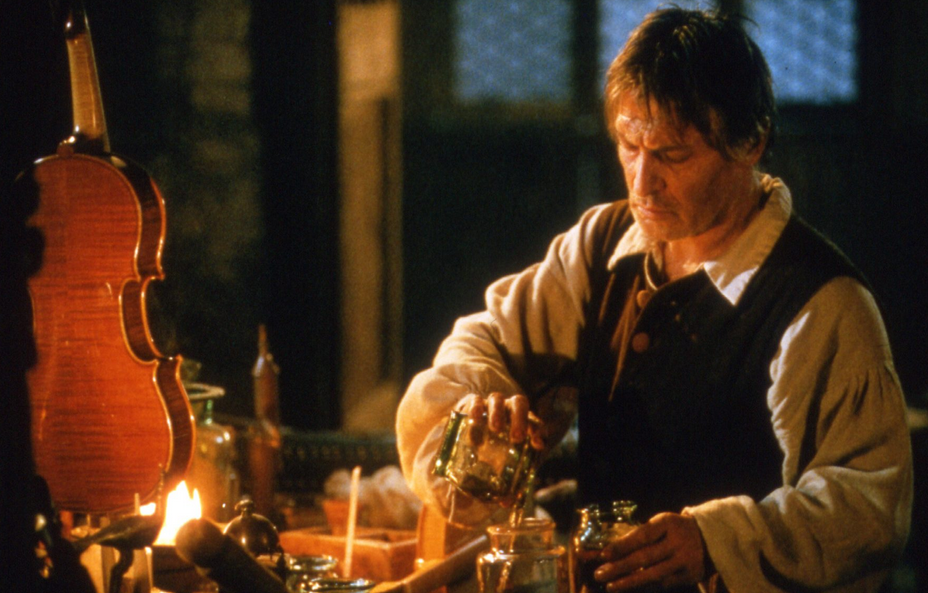
I don’t sleep with a violin in my bed, but there is something very magical about the instrument. You open up the case; it’s a masterpiece, it’s gorgeous, the varnish is still there from 300 years ago. People who know violins, they look at it and it’s almost like a face. —Joshua Bell
The US Navy today has around 500 ships in active service and in reserve. The Russian navy has 300. The Royal Navy, in 1742, at its peak, had 942 vessels. But in the 1400s, China had 3500 ships and was the most powerful navy in the world, known as the Treasure Fleet. Many were five times the size of any comparable ship being built in Europe. Some were 120 metres long; Columbus’s Santa Maria was only nineteen metres.
During the reign of the Yongle emperor and under the command of the eunuch Admiral Zheng He, the Treasure Fleet routinely made trading expeditions to Africa, India, Vietnam, Java and Sumatra. But in 1424 the emperor died and was succeeded by the Hongxi emperor, who put a stop to the expeditions. By 1525, according to Jim Edwards of the Independent, the Treasure Fleet was completely destroyed, “either burned in the docks or left to rot”. The Ming Dynasty objected on cultural grounds as it felt freedom of trade was at odds with its Confucian ideology. They wanted to keep foreign influences out. In the 1470s, “the government destroyed [Admiral] Zheng’s records so that his expeditions could not be repeated”. Cancel culture, fifteenth-century-style.
Joe Dolce writes on film in every Quadrant.
Click here to subscribe
Near the end of the film The Red Violin, in late 1960s Shanghai, during China’s Cultural Revolution, all Western musical instruments were forbidden, turned in to authorities and destroyed. Anyone teaching Western music was persecuted and re-educated.
I couldn’t help thinking how this kind of sanitation of culture is on the rise again only under the guise of political correctness. The language may have changed, but the fascism is the same.
The Red Violin (1998) is a French film directed by François Girard and co-written by Girard and Don McKellar. It stars Samuel L. Jackson, Greta Scacchi, Jason Flemyng and Carlo Cecchi.
The story spans four hundred years and was filmed in five countries: Austria, Canada, China, England and Italy, featuring an evocative Academy Award-winning soundtrack by John Corigliano, with violin solos performed by Joshua Bell. It is one of the most beautiful movies about music I have ever seen, up there on the keeper-shelf with Tout les Matins du Monde (1991) and Elgar’s Tenth Muse (1996).
The story unfolds in five parts, each prefaced by the reading of a tarot card. In the first segment, in Cremona, Italy, 1681, the great violin-maker Nicolò Bussotti is about to become a father. His pregnant wife Anna consults Cesca, her servant and a Tarot card reader, to foretell her child’s future. The first card she turns over, The Moon, prophesies a long life. But during childbirth, both mother and child die.
Bussotti has just finished his masterpiece, the last violin he will ever make, and applies a red varnish in memory of his recently dead wife. We flash back to Cesca’s second card for Anna: The Hanged Man, indicating suffering for the Bussotti family.
Now we are in Vienna, a century later, in 1793, where Bussotti’s red violin has ended up in an orphanage. It is expertly played by one of the children, Kaspar Weiss, whom the monks believe is a prodigy. A top Viennese violin teacher, Georges Poussin, takes Weiss (below) under his wing, instructing him to practise mercilessly, to the click of the “Poussin meter”, an early metronome he has designed. Each week, the tempo is gradually increased until the boy is playing at blinding speed. Poussin is preparing the boy to audition before Prince Mansfeld, who seeks to discover a young musical prodigy to accompany him to Prussia. There will be a substantial financial reward for any teacher whose student can pass the interview. Unfortunately, young Weiss has a heart problem and the stress of the performance causes him to drop dead mid-performance in front of the prince. His body is taken back to the orphanage and he is buried with the red violin in a pauper’s coffin.
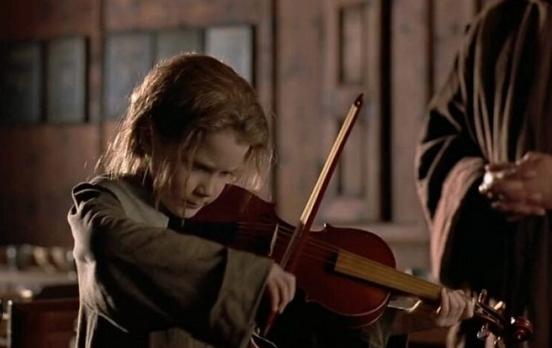
We now go back to Cesca turning over a third card: The Devil. She tells Anna it portends seduction by a handsome man.
It is Oxford, one hundred years later, late 1890s, and grave robbers have long ago dug up Weiss’s grave and stolen the red violin. The instrument has made its way over the years to England, passed amongst various gypsy bands, and finally comes into the possession of Lord Frederick Pope.
Pope is a wealthy composer and celebrated violinist who lives with his muse and lover, Victoria Byrd. When she tells him she is travelling to Russia in order to research a novel she is writing, Pope loses the will to work and takes to drugs and alcohol. In a subsequent jealous altercation with Byrd, the red violin is damaged. Pope writes a letter to her in Russia announcing his planned suicide and leaving her his entire estate. The damaged discarded violin ends up in the possession of Byrd’s Chinese servant, who takes it to Shanghai where it is sold to an antique dealer, who repairs it.
The timeline moves forward to the 1930s. A young mother visits the Shanghai antique shop and buys the violin as a present for her daughter.
In the fourth segment, Cesca turns over another card: Justice, with a forecast of a trial and persecution.
It is now Shanghai, late 1960s, during China’s Cultural Revolution. All things Western are being rounded up and burned in bonfires, including the finest European musical instruments. Zhou Yuan is a music teacher who loves Western music and keeps a hidden cache of old instruments in his attic.
Xiang Pei, a young political officer, received the red violin long ago as a gift from her mother and, despite her new cultural ideology, she is loath to see it destroyed. She gives it to Yuan to hide, knowing full well that they will be prosecuted if found out.
Some years later, investigating a report by concerned neighbours, police discover old Yuan dead in his secret attic, surrounded by dozens of antique musical instruments.
In the final section, the last Tarot card Cesca turns over is Death—but she reassures Anna that its upside-down position indicates not really death, but rebirth.
Now, in 1997, a new Chinese government, more tolerant of cultural differences, and no doubt also eyeing a buck, sends Pei’s impressive collection of classical instruments, including a Stradivarius and the red violin, to an auction house in Canada.
Charles Morritz arrives in Montreal to make an appraisal for Duval’s Auction House of this newly arrived crate of rare musical instruments. When he spots the red violin, he recognises instantly that it could be Bussotti’s final masterpiece. He engages a restorer, Evan Williams, to do some acoustic tests and an analysis of the unique red varnish.
Expecting positive results, Morritz has an ulterior motive. He discreetly acquires an almost indistinguishable copy of the red violin from a private collector in London.
The results of the analysis show that the violin is indeed the last Bussotti. The red colouring has been achieved by the addition of human blood to the varnish. After some further research, Morritz surmises that Bussotti has used the blood of his dead wife to stain the wood.
During the frenzied activity and distraction of the auction, Morritz switches the real red violin for the copy he has purchased. He notifies his wife in New York that he is returning with a surprise gift for their daughter.
Samuel L. Jackson, who plays Charles Morritz, is the third-highest-grossing actor of all time. When he was young, he played the French horn, piccolo, trumpet and flute in the school orchestra. He developed a stutter during childhood—and still uses the word mother****er to get through occasional speech blocks! I am particular fond of Samuel Jackson for his impromptu lyric-only “reading” of my song “Shaddap You Face” on the Jonathan Ross Show in 2007.
The character of Nicolò Bussotti is based on Antonio Stradivari, who worked in Cremona in the seventeenth and eighteenth centuries. Kaspar Weiss, Lord Frederick Pope, Victoria Byrd and Georges Poussin are also fictitious characters.
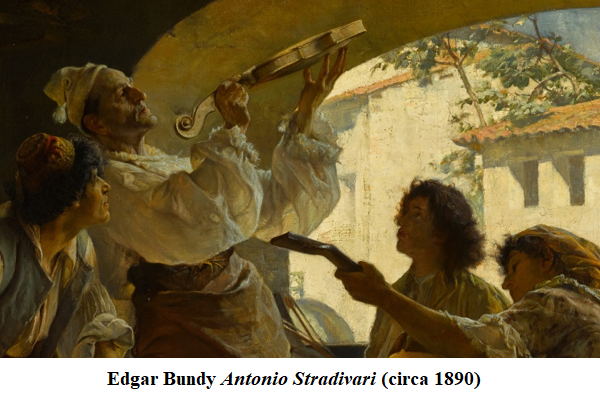
The “Poussin meter” echoes the early history of the metronome. Galileo studied the pendulum in the early seventeenth century and Etienne Loulié first adapted it in 1696 to create the first mechanical metronome. But it had no sound. The musicians watched it while they rehearsed, like a conductor’s baton. Johann Maelzel added the sound component and manufactured it, in 1816, as “Maelzel’s metronome”. Beethoven had already begun to indicate specific metronome markings in his music a year before.
The idea for the film is said to have come from the real story of the Red Mendelssohn Stradivarius, made in 1720 by Antonio Stradivari in Cremona.
Hernán Cortés conquered the Aztec empire in 1518, bringing back gold for the Spanish king. But he also brought back a stunning red dye made from the cochineal bug. Aztec royalty distinguished themselves from the common people by cloth and feathers dyed in this magnificent red. Joe Robson, a professional varnish maker, said in an article for The Strad:
The Roman Empire was ruled by a class whose name, coccinati, literally meant “those who wear red”. It is the colour of kings and queens, cardinals and demons … the varnish on Stradivari’s earliest instruments closely resembles that of his mentor, Nicolò Amati. But by the mid-1680s, his varnish had become strikingly more red and was acquiring those traits that would set his work over and above that of his considerably talented contemporaries. Cochineal varnish became the signature appearance for instruments made in the Stradivari workshop. Stradivari was making instruments for the wealthy and powerful that were literally the colour of money—and he was the only maker to have this incredible varnish.
Stradivari’s red violin vanished for two centuries but surfaced in Berlin in the 1930s. It had belonged to one of composer Felix 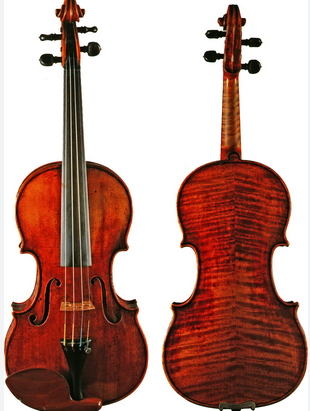 Mendelssohn’s heirs, Lilli von Mendelssohn. In 1919, at twenty-one, she had married the conductor and composer Emil Bohnke, a decade her senior, and they had three children. Emil and Lilli were killed in a car accident in 1928.
Mendelssohn’s heirs, Lilli von Mendelssohn. In 1919, at twenty-one, she had married the conductor and composer Emil Bohnke, a decade her senior, and they had three children. Emil and Lilli were killed in a car accident in 1928.
In 1956, the Red Mendelssohn (right) was purchased by a New York businessman as an investment. He kept it in perfect performance condition and thirty-four years later auctioned it, anonymously, at Christie’s in London. This auction is said to have inspired The Red Violin. An unknown purchaser, who paid just under $4 million for it, was later discovered to be the sixteen-year-old American virtuoso Elizabeth Pitcairn, who continues to play it today in concerts.
The music for The Red Violin was created by American composer John Corigliano. It won him the Academy Award in 2000 for Best Musical Score. He wrote the score for Ken Russell’s Altered States (1980), for which he received an Academy Award nomination. In 2001, he received the Pulitzer Prize for his Symphony No. 1.
Corigliano set some of Bob Dylan’s lyrics to his own music in Mr Tambourine Man: Seven Poems of Bob Dylan (2003). It seemed like a good idea. But it turned out to be everything that I hate about contemporary classical composer blinker-vision and lack of respect for the written word. Composed for a soprano, in something like a twelve-tone haze, the vocal writing reminded me of Kate Bush on crack. The soprano’s high timbre made Dylan’s words completely indecipherable. (Very much like the way Dylan sings now!)
One of my choral conductors once advised me that if you want the words to be understood, don’t put them in the upper ranges of sopranos. Dylan is a folk tenor. Corigliano should have scored the music for a classical tenor. A disgruntled Dylan fan once commented on this recording, “Sometimes Bob needs to be left alone.”
Corigliano said:
I had always heard, by reputation, of the high regard accorded the folk-ballad singer/songwriter Bob Dylan. But I was so engaged in developing my orchestral technique during the years when Dylan was heard by the rest of the world that I had never heard his songs … I may have heard them in the background but I didn’t stop and listen because it didn’t catch my ear …
I wrote an article at that time that asked, “How can anyone in the Western world, who considers himself or herself a serious composer, not be familiar with the music of Bob Dylan?” This sentiment was echoed, coincidentally, about the same time by Stephen Eddins for Allmusic:
Corigliano took texts from songs by Bob Dylan and treated them purely as poetry, without using or referring to Dylan’s music. He professes not to even know the Dylan originals, but frankly, it’s a little hard to believe that anyone who didn’t spend the 1960s in an isolation chamber could have avoided hearing “Blowin’ in the Wind” somewhere along the line.
Corigliano grasps neither the essence of Dylan’s unique fusion of music and lyric (which he himself doesn’t possess) nor the fundamentals of what makes a folk song work. Taking extraordinarily singable lyrical ideas and making them extraordinarily unsingable—except by the most highly-trained—is a plain waste of music paper.
Corigliano revealed his lack of understanding on what makes folk music tick with his comments on Mr Tambourine Man: “You have the same eight bars repeated like 25 times. When I first heard it, I was dumbfounded.”
Corigliano must have been sleeping in class when they were discussing the work of the Australian composer Percy Grainger, who deeply respected the folk song, and wrote: “There is no musical notation yet invented that can capture what happens when a folk singer sings.”
A more musically coherent method would have been for Corigliano to have composed a rough draft of his Dylan scores—then actually listened and learned from Dylan’s magnificent original masterpieces—and finally, totally rewritten his own work, weaving variations of Dylan’s musical themes creatively throughout, with counterpoint and inversions. This is one of the effective and memorable ways J.S. Bach developed and expanded the simple hymns of Martin Luther.
I understand the concept of bringing something new to the table but not at the expense of leaving off the legs.
Corigliano was born in 1938, and his father, John Corigliano Sr, was concertmaster for twenty-six years for the New York Philharmonic. His father arrived during the time of Toscanini and stayed through Leonard Bernstein.
John Jr was asked, in an interview with Living the Classical Life, if his father encouraged and inspired him as a child. There was a brief pause. Obviously, he was inspired by his father’s example, but he said his father did not encourage him to be a musician—he wanted him to choose something that could earn him a good living, a doctor or a lawyer.
His father believed that composers in the 1950s were writing music that audiences did not want to hear and orchestras did not want to play. His father feared his son would be doomed to a miserable life.
John Jr wrote an early composition that his dad refused to even look at. After the work won first prize in a competition, his father still refused. Several major orchestras, including one in Europe, started performing the work. His father still wouldn’t give it a listen.
Finally, one of his father’s musical associates asked if he would be performing his son’s work in a forthcoming concert. Not being familiar with the work, he finally had to listen to it. From that point on, he included the piece in all his concerts.
Corigliano lives with the composer-librettist Mark Adamo. They were married in California just prior to the enactment of Proposition 8.
He said he ordinarily avoids doing film scores because the composer isn’t in control of what happens. He told David Sterritt of the Christian Science Monitor:
I did [The Red Violin] because it’s such a music-driven film … Leonard Bernstein did only one movie—On the Waterfront—because in the middle of his beautiful love theme, Marlon Brando belched, and the director [Elia Kazan] took the volume of the love theme down, and then brought it back up after the belch. Bernstein never did another movie.
American solo violinist Joshua Bell is featured throughout the soundtrack on a Gibson (Huberman) Stradivarius, from Stradivari’s golden period of 1713. He purchased it in 2001 for just under $4 million. A prodigy, at fourteen Bell was a soloist with the Philadelphia Orchestra, and he made his Carnegie Hall debut at seventeen in 1985.

I remember first encountering Bell when he was part of an experiment initiated by Gene Weingarten of the Washington Post. Wearing a baseball cap and street clothes, Bell busked anonymously in a Washington DC Metro station. Over a thousand people passed him—and only one recognised him. He played for forty-five minutes and earned $32. Three days before, he had performed the same selection of music to a sell-out crowd in the Boston Symphony Hall. Weingarten won the 2008 Pulitzer Prize for an article on this social-musical experiment.
Tarot cartomancy is fortune telling using a deck of Tarot cards. Its practitioners are known as cartomancers. Tarot card reading began in fourteenth-century Europe. The standard Tarot deck consists of seventy-eight cards (the Major and Minor Arcana), that, according to Brigit Esselmont, founder of Biddy Tarot, “depicts symbolic archetypes that allow us to tap into our intuition”.
The fifteenth century was considered the golden age of Tarot card design but very few cards are in existence from that period. One-of-a-kind decks were commissioned by the wealthy. Suits had names like Eyes, Whips, Darts and Vases. Three-line descriptive poems accompanied each card. The tone was often cynical, especially regarding love. Some decks featured military leaders, Roman gods and figures from the Bible.
Reviews of The Red Violin have been generally positive. Roger Ebert said, “There is a kind of ideal beauty that reduces us all to yearning for perfection. The Red Violin is about that yearning.” Bob Graham of SFGATE wrote: “the Cultural Revolution sequence is very good at re-enacting the anti-intellectual lockstep of the time”. Sterritt said, “Most films have music doodling in the background, but occasionally a movie takes the unusual step of making music a full partner. Such is The Red Violin.”
There were a few negative comments. Marc Savlov of the Austin Chronicle wrote, “Jackson is woefully miscast here, and as a result spends much of his time struggling to define his role as a ‘serious’ collector of objets d’art in this muddled-though-gorgeous omnibus film.” My favourite thrashing is this funny one by Paul Tatara of CNN:
Jason Flemyng plays the composer [Frederick Pope] as if he’s a cross between Franz Lizst and Mick Jagger during his “Get Yer Ya-Yas Out” period, with Greta Scacchi on hand as his oversexed muse. Given the quality of the previous sequences, this one is stunningly foolish, both in conception and execution. A couple of shots are real howlers, including the sight of Flemyng locked in Playboy Channel intercourse with a young female fan while he’s playing the violin. Those of you who’ve had intercourse might wonder how he keeps his mind on the various fingering techniques. The rest of you may just wonder where the exceptional film you were watching suddenly disappeared to.
There is a subtle parallel and a moral anomaly in the storyline of The Red Violin. In the 1930s, the mother of Xiang Pie acquires the red violin from an antique dealer in Shanghai as a present for her daughter. In the 1990s, art appraiser Morritz switches the real red violin for a copy, also as a present for his daughter. In the former instance, the instrument is purchased as an act of love for a child, but in the latter instance Morritz defrauds both the unaware buyer and the auction house with a fake. One would imagine this multi-million-dollar deception would be discovered sooner or later but I think we’d need another Tarot card to predict the consequences.
 Sign In
Sign In 0 Items (
0 Items ( Search
Search







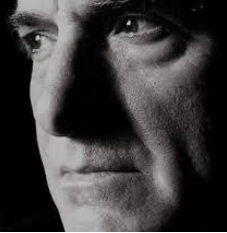


When I read of Jackson being in the film , I recoiled in disgust . The most vulgar , scenery chewing actor in Hollywood , in a film about a historical violin !? Didn’t know he played those instruments though – maybe I’ll give it a chance .
I watched at least four times at Brisbane, County Comfort, about 20 years ago and despite a barren search, it pops up here! I loved it, captivated emotionally blood stained into the wood. Ignorant of the caste, the story beholden was a pleasure without that baggage. Remain perplexed of its low profile, then maybe why it is prominent here.